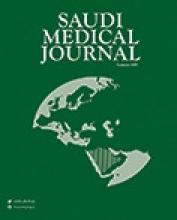Abstract
OBJECTIVE: To ascertain whether white blood cell (WBC) count with differential analysis may predict severity of disease in acute appendicitis.
METHODS: We conducted this retrospective study on appendectomy patients from 1996 to 2001, at King Khalid University Hospital, Riyadh, Kingdom of Saudi Arabia. We reviewed patient's age, gender, duration of symptoms, temperature on admission, WBC count including differential and the histological diagnosis of the appendicular specimen. We further analyzed the data of those patients found to have acute, gangrenous and perforated appendicitis to determine the correlation between a high WBC count and a more advanced form of appendicitis.
RESULTS: Out of an aggregate of 232 patients, 162 were males and 70 females with a mean age of 23.7 years (range, 12-70 years). Mean duration of symptoms was 1.9 ± 1.1 days, mean temperature 37.8 ± 1.4 degree celcius, with reported elevated WBC count in 167 (71.9%) and normal in 65 (28.1%) cases. Mean WBC counts in acute were 14.5 ± 7.3 x 109/L, gangrenous 17.1 ± 3.9 x 109/L and perforated appendicitis 17.9 ± 2.1 x 109/L. This reflected a persistently higher WBC count in the complex (gangrenous, perforated) appendicitis compared with acute appendicitis (p less than 0.05). The differential analysis showed neutrophilia in 123 (53%) and lymphopenia in 112 (48%) cases and out of these, 116 (94%) with neutrophilia and 107 (95%) with lymphopenia were reported to have appendicitis.
CONCLUSION: A high WBC with differential count is a reliable indicator of the severity of appendicitis and signifies a more advanced stage.
- Copyright: © Saudi Medical Journal
This is an open-access article distributed under the terms of the Creative Commons Attribution-Noncommercial-Share Alike 3.0 Unported, which permits unrestricted use, distribution, and reproduction in any medium, provided the original work is properly cited.






